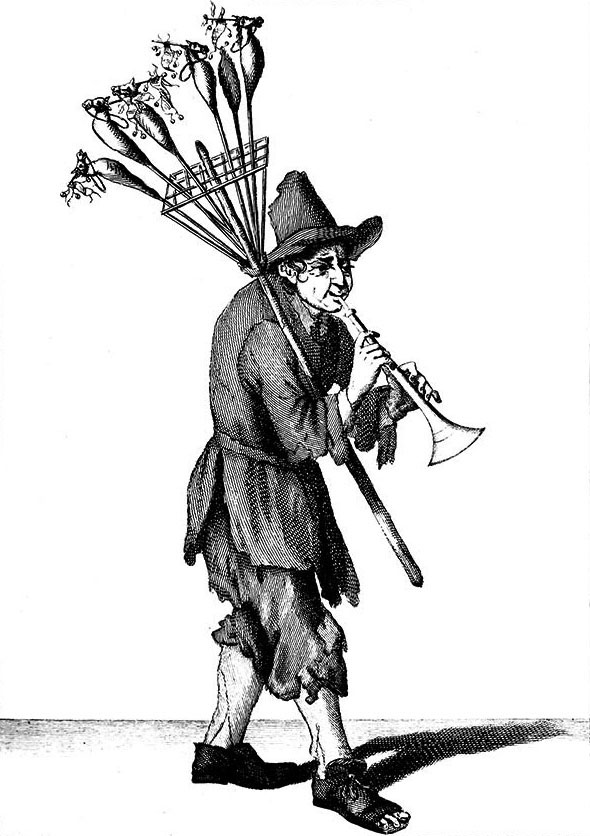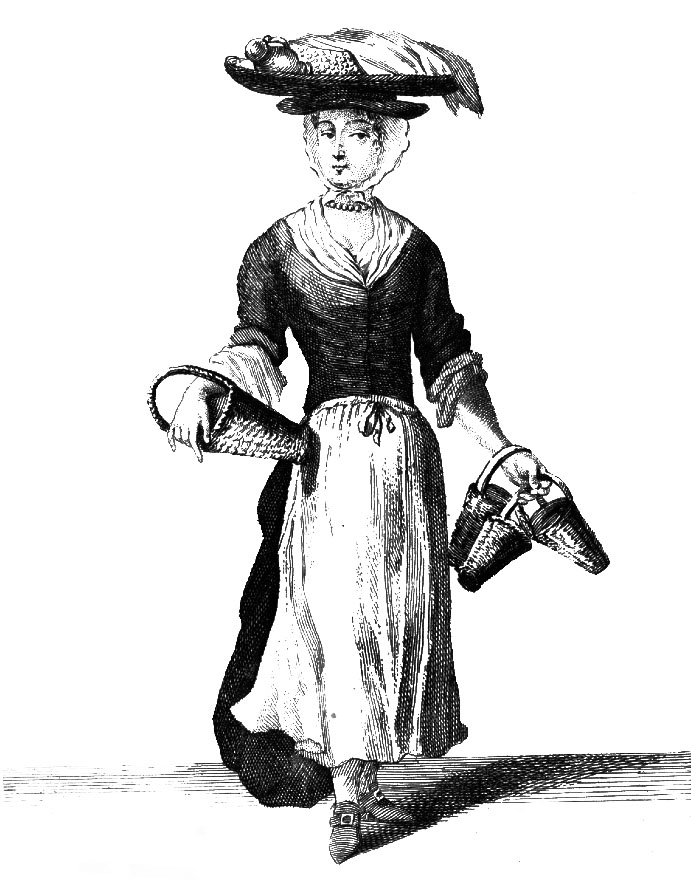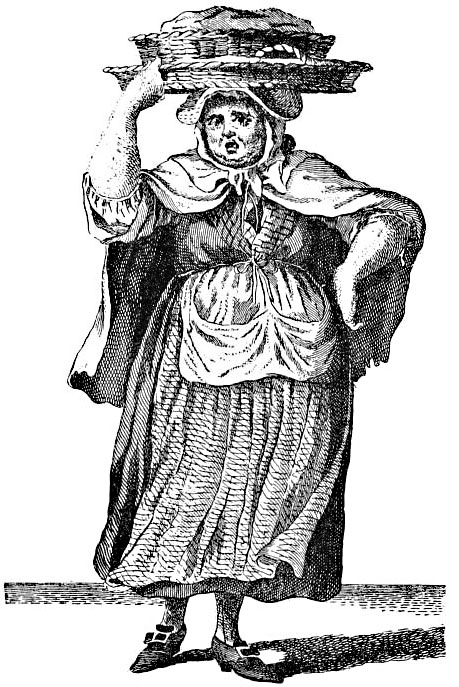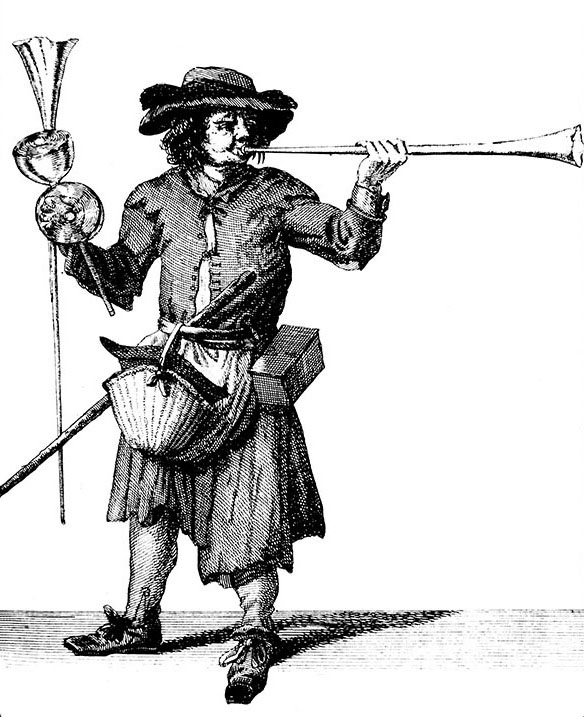The history of London’s markets is a noisy one, where the ambient buzz of the crowd is overlaid with the musical Cries of the people who work there. In this essay, Duncan MacLeod reflects on the sociological and sonic history of those cries, and draws them into a lineage which culminates with his own sound piece, “The Cries of London”.
“The Cries of London” is an ongoing series of electroacoustic compositions and sound works that draw upon the urban anthropophonic soundscape of London. Taking inspiration from the seventeenth‑century works of the same title by Thomas Weelkes and by Orlando Gibbons, this series centres on the human voice within the city, capturing vocalisations drawn from London’s street‑markets. 1 At its core, “The Cries of London” is a response to the presence of the voice within the city where changes in commerce, alongside the forces of inequality and privatisation of public spaces, threaten to “silence the speech of the city”. 2
Since the mid-nineteenth century, public vocalisations in London have been on the wane as a result of direct legislation, changes in commerce and most recently the emergence of digital technology. 3 More recently, the privatisation of public space and introduction of by-laws such as Public Spaces Protection Orders 4 loom large as contributing factors to “the silencing of public space”. 5 Although not immune to such factors, licensed street markets offer a territory in which diverse and marginalised communities can be present and coalesce. They support the cultural heritage and identity of a neighbourhood both through the produce that is sold and the unique multi-modal sensory experiences that they offer. The composer Barry Truax elaborates that sound not only reflects the complete and geographical context of a community but can also “reinforce community identity and cohesion”, and adds that “acoustic experience creates, influences and shapes the habitual relationships we have to any environment”. 6 Indeed, the soundscapes of street markets have an architectural quality that can create space, and provide a sense of territory to those in earshot. As such, in the words of the Greater London Authority (GLA), “markets are an expression of communities that can help build a strong sense of local identity”. 7
A history of cries
Throughout the centuries, London’s working‑classes have relied upon itinerant traders and street markets as a convenient and affordable source of food and produce. These independent traders, often known as costermongers or costers, pedlars, hawkers, fishwives, tinkers, or barrow boys would call out a repeated phrase to advertise their wares. A practice, otherwise known as “cries” or “crying out”, that is still heard in many street-markets today. The nature of cries has a distinct musical prosody; namely speech‑melody and rhythm. These were often embellished and extended into songs that provided a recognisable “hook” or trademark to attract regular custom. As noted in a letter published in The Spectator in 1711, “people know the wares they deal in rather by their tunes than by their words”. 8 Consequently, a tradesman’s cry was a valuable asset, often passed down from generation to generation; Peter Ackroyd notes:
Even as a poor trader died – or left some scanty stock to another – his or her cry was taken up like an echo. 9
Before the prevalence of cars in the twentieth century, cries were a prominent feature of the urban soundscape. As Samuel Johnson reported in 1753,
the attention of a newcomer is generally first struck by the multiplicity of the cries that stun him in the streets. 10
These vocal advertisements would change throughout the day and year, thus marking the passing of time and seasons through sound. The cries were generally more than a simple announcement of goods often incorporating an extensive litany of a product’s virtues. It was also customary to incorporate satire, witticisms, and even conundrums into the cries to amuse and attract the attention of passing customers. As such, street traders were performers, claiming the streets as their theatre in an attempt to stand out and be recognised amid the noise and bustle of the crowd.
A culture of cries
Over time, the ubiquitous cries of street traders have “fostered a sense of place”11 and became an integral part of London’s urban identity. This relationship has been reinforced over centuries through various cultural representations that “suggest a self-conscious, almost ethnographic attentiveness to details of daily life”.12 In literature, authors have drawn upon the cries to conjure the urban aurality of London as found in the works of Jonathan Swift, Charles Dickens, Henry Mayhew and Christina Rosetti, among others. One of the earliest examples can be found in the fifteenth century satirical poem, “The London Lickpenny”, ascribed to John Lydgate, that charts a farmer’s journey to London and the hawkers’ cries he hears: “Ribs of beef and many a pie!” and “Strawberry ripe, cherries in the rise!”. 13
More prominent, however, are the illustrated portraits of itinerant traders that appeared in the early seventeenth century and grew in popularity to become a genre in their own right, also known as “Cries”. Over the centuries, the iconography of cries has featured in numerous publications, from children’s books to broadsheets and playing cards to prints. These were purchased as both cheap souvenirs and highly valuable etchings. The lifelong bibliophile Samuel Pepys was a prominent collector of these pictorial cries and his collection of over ten thousand engravings, now housed in the Pepys Library at Magdalene College, Cambridge, includes some of the earliest surviving examples. These illustrations remain vital and rare documentation of working-class Londoners from the period. Although many of the artists are unknown, some of the more famous cries are attributed to painters including Marcellus Laroon, Paul Sandby, Francis Wheatley, and William Marshall Craig.
Sonically speaking, it has been suggested that cries may have been one of the earliest forms of popular music, perpetuated in numerous ballads and nursery rhymes. 14 Early examples of cries feature in several anonymous vocal rounds and canons such as “New Oysters” and “Brooms for old shoes”, collected and published by Thomas Ravenscroft in the early 1600s. 15 In the late nineteenth century the Folk-Song Society (today the English Folk Dance and Song Society) began collecting and transcribing cries in musical notation, some of which were arranged and published for voice and piano accompaniment. One of the most famous being a lavender seller’s song “Sweet Scented Lavender”, fragments of which feature in Lionel Bart’s song “Who Will Buy?” from his 1960 musical Oliver! More recently, Muhammad Shahid Nazir, a market trader selling frozen fish in Queen’s Market, east London, found fame in 2012 after a video recording of his cry “Come on ladies! Come on ladies! One pound fish!…” went viral on YouTube.16 Nazir, otherwise known as One Pound Fish Man, went on to appear on The X Factor UK, secured a recording deal with Warner Music, and an arrangement of his cry reached number four in the UK dance charts in 2012.
In art music, the cries first appear in the aforementioned renaissance compositions of Thomas Weelkes and Orlando Gibbons, as well as Richard Dering. 17 Written for multiple voices and instrumental accompaniment, these free-form compositions, otherwise known as fantasia or fancys, see the composers combine cries and traders’ songs with original composed material in the form of imitative counterpoint. These quodlibets are a curious mix of interwoven material with moments of humour and delight that combine bawdy folk melodies with sophisticated contrapuntal writing. 18 The musicologist John Hawkins points out that these works not only incorporated the words of the cries but retained “the very musical notes of them” thus providing soundbites of Elizabethan London. 19 Beyond the Renaissance, the cries have continued to inspire later generations of composers including Luciano Berio, Ralph Vaughn Williams, and George Frideric Handel, who is supposed to have remarked that “hints of his very best songs” were “owing to the sounds in his ears of cries in the streets”. 20
The Cries of Columbia Road
The first work in my own Cries of London series is “The Cries of Columbia Road” (2017) which draws upon the soundscape of the Columbia Road Flower Market located in Bethnal Green, east London. Established in the mid-nineteenth century, the market initially started as a Saturday market, and as the local Jewish population grew a Sunday market was established as well. Over time the Saturday market lapsed whilst the Sunday flower market flourished, selling plants and flowers grown by local residents alongside leftover stock from Covent Garden Market.
21
The market today consists of 50 stalls, many of which have been passed down through generations of the same working-class families.
“The Cries of Columbia Road” is a sonic portrait comprising a montage of vocalisations and non-vocal sounds which attempts to imbue a sense of place and understanding of the Columbia Road environment. The inclusion of non-vocal sounds deliberately draws upon what composer Denis Smalley defines as “source bonding”:
the natural tendency to relate sounds to supposed sources and causes, and to relate sounds to each other because they appear to have shared or associated origins. 22
A variety of non-vocal sound objects thus feature within the work, such as the rustle of paper being wrapped around flowers and the clatter of trolleys.
As with other compositions in the series, the duration of the work reflects the time it takes to walk the distance of the market. The formal structure of the work sees the general bustle of the market act as a ground against which cries are overlaid and juxtaposed. The order of cries mimics the physical location of each stall as one might encounter them when walking through the market. The recordings featured within the work were captured over a period of three weeks, utilising a combination of directional, and in-ear binaural microphones. The use of processing is minimal with the exception of some attenuation of unwanted elements, namely distortion and artefacts from the recording device. The decision to do so was born from a desire to foreground traders’ cries so to ensure their musical prosody can be heard.
As my first foray into working with an urban soundscape, “The Cries of Columbia Road” has broadened my appreciation and understanding of the acoustic ecology of urban communities. As Barry Truax explains,
within a larger social group, pervasive and complex acoustic interactions create … an “acoustic community”, that is, a bounded space where the shared experience of everyday sound creates identity and dynamic relationships, a system that can be regarded as an acoustic ecology. 23
Indeed, my initial listening to recordings of the market had a transformative effect. With the sound disembodied from its source, I became acutely aware of sonic details that I had not heard or appreciated at the time of recording. To quote a similar experience by the composer Pauline Oliveros, I came to realise:
how selectively I had listened, and that the microphone discriminated much differently than I did. 24
As such, I came to appreciate a number of salient features within the soundscape that is, as artist Sophie Arkette observes,
imbued with its own lexical code: sound as sign, symbol, index’ which reflects the social and geographical context, and communal identity of the market. 25
On a linguistic level, an acoustic community is heard in the light-hearted conversations between traders and customers. These encompass a variety of topics from general small talk and banter through to shared jokes and advice on plant care. As for cries, these focus on descriptions of goods and their cost which are mixed in with general sales patter, witticisms, and the occasional offer of “buy one get one free”. The phrases themselves have varying degrees of complexity from short succinct alerts “Come On!” and repeated phrases “Tenner only, Tenner only, Tenner only!” through to full stanzas “Come on! Last of it! All gotta go, we’re going home early tonight! Come on buy, don’t be shy, wholesale money!”. All of which feature, as one might expect, elements of speech that are synonymous with east London, namely the prevalence of cockney and estuary English accents, abbreviated words, slang, and terms of endearment “fella… darlin’… sweetheart…” that reinforce a sense of place, community, and geographic location.
Tenner only, Tenner only, Tenner only!
The musical prosody of cries, namely speech-melody and rhythm, range from relatively simple one or two note patterns, through to more complex and distinct melodic phrases that resemble song structures. The character of these structures is animated through a range of vocal styles, each with their own distinct timbral quality, tone and resonance. Expressive detail is present through a combination of projection, dynamic phrasing and subtle changes in tempo. Similarly, a variety of vocal techniques is utilised, the majority of which appear to use Sprechgesang, a hybrid technique that is half spoken half sung. Moreover, certain cries are repeated and passed amongst traders that become a recurrent motif, or soundmark, that can be heard throughout the market. This is commonly found on large stalls that have several traders selling the same goods, such as the tulip sellers, whose cries intertwine and produce a heterophony of voices that mark out a sonic territory within the market. More remarkable, however, are the moments of unison in which the market seemingly erupts at random to the collective cheer of traders Crying “Oi! Oi!” before returning to their own cries and sales patter.
These elements combined result in a contrapuntal texture in which voices seemingly interlock and respond to one another. Indeed, the melodic shape and tonality of each discrete cry appears to complement the others heard around it, forming tonal centres and harmonic relationships that alludes to a deeper underlying connection between traders. The nineteenth-century musicologist Joseph Mainzer, who collected and researched Parisian cries, attributes this connectedness as being an instinctive sensory response to one’s environment, namely: “The closer man is to the state of nature, the more he is influenced by the impression of the senses.” 26
Oi! Oi!
Conclusion
Throughout London’s history, street markets and itinerant traders have held a divisive position that reflects the wider class struggles of the city. Indeed, street traders have over time become “a representative ‘type’ of the working‑class Londoner”. 27 On one hand revered and respected by the communities that they serve and, on the other, regarded as a necessary nuisance by those in authority that considered them unrefined relics of the past. As such, street traders have had to navigate various attempts by the authorities to regulate, limit, and in some cases prohibit, their existence. As historian Stephen Jankiewicz observes, streets are not blank or empty voids, “but a space where the battle over political authority and communal identity [is] fought every day.” 28 In spite of this, the cries of traders continue to be heard in the face of adversity; a resilient living tradition that has been passed down through generations and forms part of London’s cultural heritage. Heard throughout the ages, the cries survive, as Sophie Boutin explains,
as a ‘sound memory’, that is to say, an unadulterated national relic and spontaneous expression of popular voice. 29
Their presence and place has been affectionately documented in various forms, as summarised by the author James William Sullivan:
The ‘coster’ [another term for the street seller] has his place, in song and story, in verse and picture, as one of London’s best-known characters. He is of the people, for the people. 30
In many respects, this ongoing series of sound works and compositions is another stage in a continuum of the cultural representations of cries that are more than nostalgic reflections of urban life, but rather:
mediated cultural objects that have the potential to reveal more than the sum of their parts to the attentive listener. 31
As urban designer Sara Adhitya observes, sound mapping can reveal the social dimension of the city, rather than just its physical urban structure, thus “providing a much deeper experience than just looking at a map”. 32 As such, the use of urban soundscapes in composition has the potential to express social nuances that might otherwise be overlooked. It can also foreground the value of sound as a means to further understand and appreciate urban communities. Attuning perception of the urban soundscape as being not just perfunctory noise but rather a dynamic acoustic ecology that can impart distinct and meaningful insight.
- Orlando Gibbons, The Cryes of London (c.1610); Thomas Weelkes, The Cries of London (c.1610).
- Saskia Sassen, “Does the City Have Speech?”, Public Culture, 25, 2 70, (2013), pp.209–221.
- Such legislation includes, amongst others, the Metropolitan Police Act 1839; the Pedlars Act 1871; Local Government Act 1982; Public Order Acts of 1936 & 1989; A.D. Singleton, L. Dolega, D. Riddlesden, P. A. Longley, “Measuring the spatial vulnerability of retail centres to online consumption through a framework of e-resilience”, Geoforum, 69, (2016), pp.5–18.
- For more on Public Spaces Protection orders see: Bradley L Garrett, “PSPOs: the new control orders threatening our public spaces”, The Guardian, September 8, 2015.
- Manifesto Club, “The Silencing of Public Space”, report, November 24, 2019, available online: manifestoclub.info/the-silencing-of-public-space (Last accessed 03.09.20).
- Barry Truax, Acoustic Communication, (New Jersey, Ablex, 1984), pp.10–11.
- Greater London Authority, Understanding London’s Markets. Report London: GLA (2017), p.13.
- Joseph Addison, “The Cries of London”, The Spectator. No. 251 (December 1711).
- Peter Akroyd, London: The Biography, (London, Chatto & Windus, 2000), p.181.
- Ed. Peter Martin, Samuel Johnson: Selected Writings, (Cambridge, Harvard University Press, 2009) p.120.
- Aimée Boutin, City of Noise. (Champaign, University of Illinois Press, 2015), p.60.
- Deborah L. Krohn, “Quodlibets and Fricassées: Food in Musical Settings of Street Cries in Early Modern London” in Melissa Calaresu & Danielle van den Heuvel (Eds.), Food Hawkers, Selling in the Streets from Antiquity to the Present (London, Routledge, 2016 ), p.47.
- Daniel Scrymgeour (ed.), “London Lickpenny” in The Poetry and Poets of Britain, (London, A. & C. Black, 1850), p.23.
- John Shepherd, Continuum Encyclopedia of Popular Music of the World Volume II. (London, Bloomsbury, 2003) p.170.
- These rounds and canons feature in three anthologies self-published by Ravenscroft: Pammelia. Mvsicks Miscellanie (1609); Deuteromelia (1609); and Melismata, Mvsicall Phansies (1611), (facsimile Amsterdam, Da Capo Press, 1971).
- James Timbers, One Pound £1 Fish Singing Salesman London HD, (2012). Available online: youtu.be/m_Jvo7U39-A (Last accessed: 25.06.20).
- These works first appeared in manuscripts such as Thomas Myriell’s 1616 collection Tristitiae remedium. Cantiones selectissimae, diversorum tum authorum, tum argumentorum; labore et manu exaratae. The works were later arranged in the twentieth century by Frederick Bridge and Philip Brett, published in F. Bridge, The Old Cryes of London, (London: Novello, 1921); and P. Brett, “Consort Songs” in Musica Britannica, Vol 22. (London, Novello, 1967).
- A quodlibet is a composition that combines several different melodies, often in a humorous and light hearted manner.
- John Hawkins, A General History of the Science and Practice of Music. Vol. 4, (first pub. London, T. Payne and son, 1776), p.18.
- Luxborough, Letters written by the late Right Honourable Lady Luxborough, to William Shenstone, (Dublin, printed for Caleb Jenkin, 1776), p.55.
- Linda Wilkinson, Watercress But No Sandwiches (London, Linda Wilkinson, 2018).
- Denis Smalley, “Spectromorphology: explaining sound-shapes”, Organised Sound 2, 2, (1996), p.110.
- Barry Truax, “Voices in the Soundscape: From Cellphones to Soundscape Composition.” in Zakharine, D. & Meise, N. (ed.) Electrified Voices. Medial, Socio-Historical and Cultural Aspects of Voice Transfer. (Göttingen, V&R unipress, 2013) p.62.
- Pauline Oliveros, Software for the people, (Vermont, Smith Publications, 1984), p.182.
- Sophie Arkett, “Sounds Like City” Theory, Culture & Society. Vol. 21(1), (2004), p.160.
- Joseph Mainzer, “Revue et Gazette Musicale”, (September 20, 1835) cited in Murphy, K. (1994) “Joseph Mainzer’s ‘Sacred and Beautiful Mission’”, Music & Letters, Vol. 75, No. 1, (1994), p.41.
- Victoria Kelley, “London’s Street Markets: The Shifting Interiors of Informal Architecture” The London Journal, Vol. 45, No. 2, (2019), p.2.
- Stefan Jankiewicz, Ibid., p.398.
- Sophie Boutin, City of Noise (Champaign, University of Illinois Press, 2015), p.57.
- James William Sullivan, Markets for the People: The Consumer’s Part (New York, MacMillan, 1913), p.224.
- Deborah L. Krohn, Ibid., p.47.
- Sara Adhitya, “The City Soundscape and the Brain”, Future Sound of Cities conference paper, July 2014, p.175. Available online: (Last accessed 03.09.20). invisibleplaces.org/2014/pdf/ip2014-adhitya.pdf



